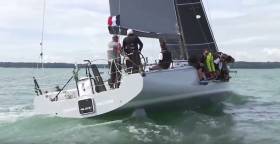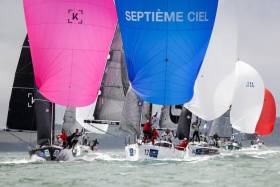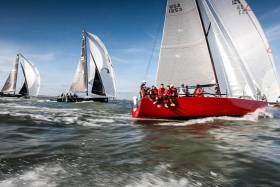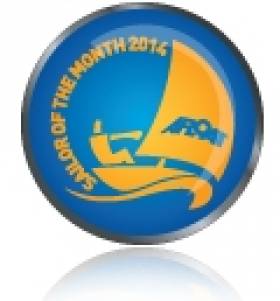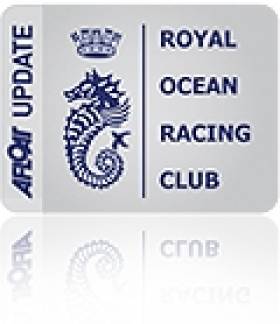Displaying items by tag: commodore's Cup
Commodore's Cup Gets Underway in Cowes This Sunday
Racing gets underway this Sunday at the third IRC European Championship, for the first time being held out of Cowes. The IRC Europeans will incorporate the Commodores' Cup, the Royal Ocean Racing Club's biennial event for three boat teams with amateur crews. For this season these two events have been merged to reduce demand on owners and crews' time.
Entry requirements have been eased significantly for this, the 14th edition of the Commodores' Cup. There are no longer rating bands, no requirement that one boat must be a 'big boat' and teams no longer have to represent a nation or a region. Any three boats entered in the IRC Europeans can form a team, but as the Commodores' Cup is a Corinthian event, professional sailors are limited to one per boat (boats only entering the IRC Europeans have no such restriction).
The 2018 Commodores' Cup sees the return of the Celtic Team, masterminded by renowned Scottish adventurer, Jock Wishart, who is once again campaigning Jean-Eudes Renier's JPK 10.80, Shaitan. Backed by Aberdeen Standard Investments, the team also comprises the First 40 Adventurer (Rob Bottomley's Sailplane) and Andy William's Ker 40 Keronimo. Among the teams' pros are old hand David Bedford on Shaitan, while sailmaker Kevin Sproul will race the Commodores' Cup for a third time on Keronimo, having won the event aboard her in 2012 with original owner Jonathan Goring.
The GBR RORC Green team sees the return of RORC Admiral Andrew McIrvine for his fifth Commodores' Cup. His First 40 La Réponse will be joined by Tom Kneen, whose JPK 1080 Sunrise put in the best performance across the two British teams in 2016. This time Kneen will be racing his latest Sunrise, a brand new JPK 1180. The team's third boat is Ed Fishwick's heavily campaigned Sun Fast 3600 Redshift Reloaded, with former National Match Racing Champion turned Figaro sailor, Nick Cherry.
Another team from the UK is Kings High. This comprises Mike Bridge's Elan 37 Elaine, whose crew are regular competitors at the RORC's annual IRC Nationals but are having to dust off their sea boots for the offshore races in this year's event, plus two King 40s, Roger Bowden's Nifty and the Blair family's Cobra, current leaders in the Performance 40 class.
"We've been planning it for a year and a half and have been building up to it through the course of this season - we are really looking forward to it," says Cobra skipper Stevie Beckett of this year's event. Cobra competed in the 2016 Commodores' Cup and according to Beckett they deliberated hard about the make-up of this year's team: It was felt having two King 40 sisterships racing each other might coax out the best performance from each. While the King 40 excels in lighter breeze, Beckett says "our crew work is really good now, so we'd like a bit of everything weather-wise."
Meanwhile, boats are arriving in the Solent from across Europe. One of the hot teams from France will be the J/112e J Lance 12, skippered by Didier Le Moal, Managing Director of J Composites, European manufacturer of J/Boats. "We are sure it will be a great competition," says Commercial Manager Frédéric Bouvier, J Lance 12's boat captain. They are also using the event "to prove that you can still win races with a pure cruiser-racer." This is the third J/112 they have campaigned but J Lance 12, launched in March, is the first fitted with a 'grand prix' package including a carbon fibre mast, fin (rather than bulb) keel and other race boat features. "We are trying new systems, which might be useful on future boats," explains Bouvier.
The team has been highly successful racing on France's Atlantic coast, winning all they entered in 2017. On board for the IRC Europeans is reigning Solitaire du Figaro winner and Volvo Ocean Race navigator, Nicolas Lunven.
Making the trip down from Scotland is Rod Stuart and Bill Ram's Corby 37 Aurora, a competitor in the last two Commodores' Cups. The team is making use of a new RORC initiative permitting boats with either two females or two under 25-year-olds (or one of each) can carry an additional crew. "That is really good," says Stuart. "It's a great way of getting younger people competing at events of this level. It means my 15-year-old son James can sail with us. Previously he would have been watching from a RIB, this time he will be in the thick of the action..."
According to Stuart the last two Commodores' Cups were both Aurora's poorest results in her season so he hopes it will be "third time lucky... The banding of Class 2 is much tighter than before - that's good because you're up against similar speed boats. We've raced against most of the class at one time or another and sometimes we have beaten them and sometimes they have beaten us. We know when we are on form we can do it - but it will be tough."
Stuart also enjoys the mix of inshore and offshore races - the IRC Europeans schedule is near identical to that of recent Commodores' Cups, but with the race around the Isle of Wight brought forward:
Sunday 10th June - two inshore races
Monday 11th June - Race around the Isle of Wight
Tuesday 12th June - two inshore races
Wednesday-Thursday 13-14th June - long offshore race
Friday 15th June - two inshore races
Saturday 16th June - two inshore races
On the social side, there is a Welcome Party following the skippers briefing on Saturday 9th June, a Crew party on Thursday 14th June and the event concluding with a prizegiving on the final day.
Commodore's Cup Video Action
Great action shots and interviews with some of the top sailors in this week's premier biennial regatta on the Solent, the Brewin Dolphin Commodores' Cup.
France Blue Back in Charge at Commodore's Cup
The Brewin Dolphin Commodores' Cup race course took on a different complexion today. A front passed through early morning leaving behind it a lumpy sea, further kicked up by a strong eastbound tide. Conditions gradually abated and the sea flattened in the afternoon, but it made for a brisk start to day four of the Royal Ocean Racing Club's biennial flagship event for three boat teams sailed by Corinthian crews.
For the first time, today's courses were set in the western Solent, with the committee boat moored close to the Beaulieu river entrance and the weather mark off Hamstead on the Isle of Wight shore.
The lively conditions created one casualty before the start gun had even fired. On the biggest boat in the race, the Goubau family's Beneteau 47.7 Moana (Flanders North Sea), the mainsail suffered a severe luff to leech rip during a pre-start gybe. Fortunately the Belgium team had its delivery mainsail back in Cowes and raced back to fit it, but in doing so scored maximum points for missing race five.
As Moana helmsman, Mathieu Goubau recounted: "It was very stressful. We had to get back, so we went as fast as we could, but we just made it back in time for the second race."
With the strong flood tide and the southwesterly wind, all the boats immediately tacked after the start and then short tacked up the mainland shore until they had to make the long trans-Solent starboard tack across to the weather mark. As Tanguy Caradec, navigator on the Prietz family's Ker 39 GOA (France Blue), winner of today's first race, described it "by the shore, the tide was a knot or less. In the middle when you had to cross, it was about 2.5 knots. The laylines were very hard to call."
The first beat saw the race's second casualty as Simon Henning's modified Mumm 36 Alice (GBR Red) struck the bottom while short tacking up the mainland shore. She retired from that race and tonight is behind hauled out to assess any damage.
GOA's win, with an okay result from their small boat Daniel Andrieu's Sun Fast 3200, Cifraline 4, was enough for France Blue to regain the lead.
The second and final race of the day was a giant round the cans affair in the western Solent, finishing off Egypt Point. This saw the France Blue big boat, Eric de Turkheim's A13 Teasing Machine, claim honours ahead of Andrew Williams' Ker 40, Dan, Israel (Keronimo), enough to consolidate France Blue's first place on 110.5 points, 12.5 ahead of France White, with Flanders North Sea just another two points back.
The best performing boats of the day were in Class 2 where Noel Racine's offshore race-winning JPK 1010, Foggy Dew (France White) posted a 2-1 and Tom Kneen's JPK 1080, Sunrise (GBR Blue) posted a 1-2.
Kneen explained: "The first race we made a good call to go on a Code 2 and not a Code 3, but mainly we've worked out that if we worked together properly and we didn't make any major mistakes we could win. And we did! And the boat is incredible. It just all came together."
The second race was more hair-raising when Sunrise's tactician Rob Gullan chose, rather than to tack after the start and short tack up the mainland shore before making a long starboard across to the weather mark, instead to do this in reverse, short tacking up the island shore, etc. Sunrise was alone in doing this.
"It was quite frightening to follow at the time - we spent the first three quarters of the race wondering if it was going to pay off, but we arrived at the top mark in the middle of Class 1," recounted Kneen. "Unfortunately then our tack line broke on the Code Zero, so we lost time on the first downwind but we managed to fend off the rest. It was a shame as we would have won otherwise."
Jock Wishart's JPK 1080 Shaitan, racing in the Celtic team, had her best day yet, posting a 3-8 in Class 2. "We had one good race and one where luck wasn't on our side," said the intrepid Scottish adventurer. "The second race we had a very good start and were in a good position, but then we blew a car and we were stuck out in the tide and had to work our way back. We just keep on trying."
Three races are scheduled tomorrow with a first start due at 10:30 BST.
For results click here
France Sets the Pace in the Commodore's Cup
Competitors from the south side of the English Channel have the upper hand after the opening day of the Brewin Dolphin Commodores' Cup, the Royal Ocean Racing Club's biennial event for three boat teams with Corinthian crews.
Day one saw Principal Race Officer Stuart Childerley lay on two windward-leeward races followed by a 'round the cans' with a reaching start. These were held in the central-eastern Solent with the start set up off Lee-on-the-Solent. The southwesterly breeze was relatively light at the time of the 1030BST start, but by the end of the final race mid-afternoon had picked up to 20+ knots, with some lumpy wind-against-tide conditions.
Stand-out team today was the favourite, France Blue, but second-placed France White is still in contact with their fellow countrymen as are their neighbours in the Flanders North Sea team.
RORC Admiral Andrew McIrvine and his First 40 La Réponse in GBR Red got off to a strong start claiming the opening race of the day, blazing down the last run with the new breeze, but was subsequently 12th in race two. McIrvine explained: "We got stuffed at the start and then got caught in traffic at every corner. But it was very close - you just had to have a couple of bits of bad luck and suddenly you were pushed down." La Réponse then salvaged a sixth in the round the cans race after a tricky first reaching leg.
In GBR Blue the 'small boat', Tom Kneen's JPK 1080 Sunrise had a similar zero to hero story: OCS in race one, but blitzing race two to take the bullet. They then suffered some technical failures in the final race, the jib breaking out of the headstay foil, followed by the Code 0 pulling out a deck fitting during the second reaching leg. "A D-ring sheared off and it nearly took our bowman's head off," downwind trimmer Marcel Herrera recounted.
Lowest scoring today was Cifraline 4, the turboed Jeanneau Sun Fast 3200 belonging to the boat's designer, Daniel Andrieu, which posted a 1-3-3. Their France Blue team mates, the A13 Teasing Machine had a disappointing second race, finishing ninth but went on to win the final race, despite suffering a major headsail wrap on the second reaching leg, north across the Solent.
"Overall we had a good day with reasonable winds. The committee did a very good job with the courses, especially the last one," said Teasing Machine owner, Eric de Turkheim. The first two windward-leewards saw the fleet taking the right side of the beat en masse, because, as Teasing Machine tactician Laurent Pages explained "there was a little bit of tide difference. It was a tricky deal because there was less current against us on the right side but there was some wind curvature and we were going into a left hand trend. It worked well in the first race, but it didn't work so well in the second."
In second-placed team France White, top performer was Emmanuelle le Men's First 40.7, Pen Koent. Today they scored a 2-4-2. "I am a bit surprised about the results, but happy, because I didn't think we'd done that well because we broke the vang," said le Men. That occurred during race two and they had to sail like that for the reminder of the day. Pen Koent is back for her third Brewin Dolphin Commodores' Cup with a crew that are all members of the yacht club at Val Andre in north Brittany.
One of the most inspiring sights today, aside from the Henning family's much modified Mumm 36 Alice seeing off 40 footers on race three's first reaching leg, was the event's longest boat, the Beneteau First 47.7 Moana, thundering around the course frequently up among the frontrunners. The Goubau family's yacht, competing in the Flanders North Sea team, enjoyed the conditions, and especially the flat water today according to mainsheet trimmer and Goubau son, Laurent: "There were no complaints and, with good speed, the tactician could do good things. We are a bit surprised, but we were happy to be in front." Moana even won the second race. "We had a very good start," continued Laurent Goubau. "The wind was going left so we headed to the pin end as fast as possible, so we were in a good position and then we kept up the speed as much as possible."
Racing continues tomorrow with the 'big one' - the traditional offshore race, due to last a 'minimum of 24 hours' and scoring with a 2.5x co-efficient.
It has been confirmed by the Irish Cruiser-Racing Association (ICRA) that it’s extremely unlikely that Ireland will be mounting a defence in July 2016 of the RORC Commodore’s Cup, which we so convincingly won in 2014 with the team of Catapult, Antix and Quokka 8. Apparently the defence has foundered on the difficulties of finding a person or group willing to take on the campaigning of a third boat which would be suitable to back up Anthony O’Leary’s 2014 Ker 40 Antix (ex-Catapult), and Michael Boyd’s new JPK 10.80. Michael Boyd and Anthony O’Leary had lined up a possible charter of Quokka 8 on a speculative (and expensive) retention fee in the hope that a team of optimal make-up could take shape, but no-one has proved willing to take up the costly full-charter option to make her the third boat. W M Nixon reflects on this unhappy follow-up to a good news story which helped lift Ireland out of the gloom of the recession in 2014.
The Commodore’s Cup 2016 as a Sail Training exercise? It’s one of the less crazy scenarios which is emerging from the conclusion that a realistic and highly-powered defence of Ireland’s 2014 win is simply not on the cards. The word is that the two front-line boats have been unable to find people with mega-resources and a crew willing to take up the third slot with Quokka, or possibly another boat altogether. Thus all bets are off.
To outsiders, it all sounds like a bit of the old hissy-fits, and more. Surely something could have been done? But those who have been in the midst of the Commodore’s Cup cauldron have some idea of both the stress involved (which is huge at the front of the fleet), and just how very much it is more important than ever to have a finely balanced team.
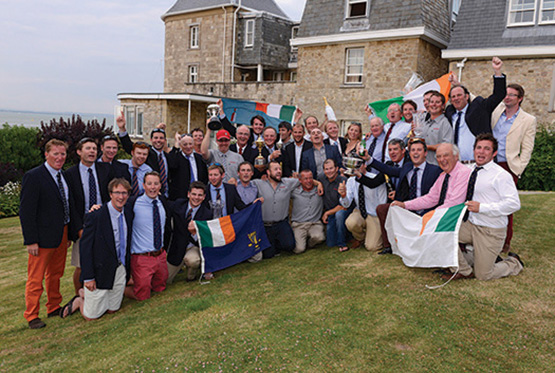
The big day – the Irish team park their tanks on the Royal Yacht Squadron lawn in Cowes after winning the Commodore’s Cup, July 2014
It all looked so easy once 2014’s win had been stitched up. But as the post-series review here on August 2nd 2014 revealed, the stresses and strains – particularly on Anthony O’Leary who did the heavy lifting in putting the team together and keeping the show on the road – were beyond most people’s imagining.
With hindsight now, it is easy to say that it was somewhere back towards Easter this year that the writing on the wall began to appear about how Ireland was going to have to opt out of the 2016 series. The new wave of Fast40+ boats on the Solent in the RORC Easter Challenge had been giving the already senior Antix a very hard time. If Anthony O’Leary and his crew were going to give of their best in campaigning their own boat in what is rapidly emerging as the hottest class in Europe, then they didn’t really need the distraction of rustling up a Commodore’s Cup team to add to their struggles.
For sure, back in 2014 the Commodore’s Cup was top billing. But the remorseless growth of the Fast 40s is making them the top show in town for 2016. They’d seven or eight of them in serious contention last year. At Easter, it was 10 and 11 boats, many of them barely out of the wrapping. In two weeks time, when they have their next major three day event on the Solent from May 20th to 22nd, we will be looking at a dozen and more boats so hot you could fry an egg on them.
Numbers like this, at this level of competition, inevitably attract the heavy hitters among owners and top professional sailors, providing a challenge which you either take head on, or opt out of altogether. For the amateur crew of Antix, it’s a case of take it or leave it. In taking it with full commitment to Fast40+ racing, they simply have to accept that they can’t overload themselves by the extra effort of running Commodore’s Cup involvement, though perhaps they could contemplate being in an Irish squad if by some miracle the perfect team package is put completely and exactly in place by some sort of offshore racing fairy godmother.
But you don’t get fairy godmothers in the rough tough world of offshore racing. The perfect dream package isn’t there, and it won’t be. So Antix and her crew of dedicated amateurs are going to be in the David and Goliath situation of throwing themselves totally into the fray of the Fast 40s, and we can only hope that the original David and Goliath scenario is replicated, for this is definitely the big boys’ game.
And yet, and yet……there’s no such thing as an inevitable outcome. Who knows what might emerge from the first proper gladiatorial confrontation of the Fast 40s in their newly confident expanded numbers? We may be saying this morning that an Irish defence is over and out. But surely it’s not beyond the realms of possibility that in the heady post-regatta atmosphere at the RORC’s Cowes base in a fortnight’s time, somebody might say: Why don’t we as a crew take a boat and join up with Antix and the new JPK 10.80 to race for Ireland?

The JPK 10.80 Courier du Leon wins the 2015 Rolex Fastnet Race
Stranger things have happened in putting Commodore’s Cup teams together in the past. In 2014, so speculative was the buildup that Anthony O’Leary admitted afterwards that until the American Ker 40 Catapult was actually unloaded from a Transatlantic ship on European soil, he wasn’t a hundred per cent convinced she was going to appear at all.
Yet ironically, there was Catapult on the quay as hoped for, after various dockside and clubhouse meetings and negotiations in Key West way back in January. But the whereabouts of the team’s third boat Quokka 8, which had been chartered by Michael Boyd and Niall Dowling, was now a matter for concern.
She’d been campaigning in the Caribbean through the winter, but had been scheduled to be shipped back in plenty of time for the start of the new RORC offshore season. But the ship she was aboard was re-routed, then re-routed again. She arrived back this side of the Atlantic barely in time for the team’s first get-together at Volvo Cork Week in July 2014. But then it all became sweetest fantasy, as Quokka won Volvo Cork Week overall, following which the Irish team won the Commodore’s Cup going away.

Quokka 8, overall winner of Volvo Cork Week 2014
So who knows what might just somehow develop. But meanwhile the critics are sharpening their knives, and there’s much muttering about it being disgraceful that Ireland doesn’t look like defending a trophy we were so pleased to win just two short years ago.
Thus a suggestion is floating around that ICRA should be prepared to allow just about any old team to go and join the scrap for the Commodore’s Cup 2016. Why not, they suggest, just allow three J/109s to go along to represent the Ould Sod, and give their crews a real taste of sailing at the sharp end?
Certainly the Commodore’s Cup as a Sail Training event has a distinct Quixotic appeal. But underneath the whole story is the reality that while in places like the Solent the top end of high-profile sailing is invariably dominated by professionals, within and around Ireland we don’t really do professional competitive sailing at all.
We’re compulsive and obsessive amateurs, and that’s the way we like it. If our sailing isn’t fitted in to cherished little slivers of free time carved out of the day job, then we don’t really think it’s genuine sport at all. Thus while it’s fine and dandy every so often to take on the Solent heavies and maybe just occasionally show them the way, we’d just as soon save our limited holiday time for a proper tilt at the West Cork Regattas or events like the ICRA Nationals, where we’re racing against people we know, and not shelling out money for exorbitant Cowes rentals. Like it or not, that’s the way we are.
Meanwhile, it’s rumoured that the 2018 Commodore’s Cup will be based of teams of just two boats each. Now they tell us…….But that’s not teams. That’s multiple doubles matches.
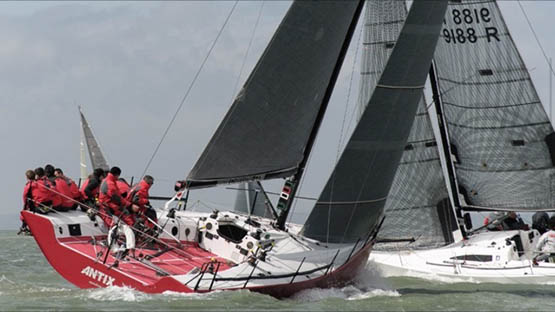
A demanding animal to sail. The tiller-steered Ker 40 Antix is not for the faint-hearted
Read also: ICRA Statement on 2016 Irish Commodore's Cup team
Ireland's Sailing Successes Celebrated In Historic Setting
#soy – Yesterday's Afloat.ie/Irish Sailing Association annual sailing awards ceremony saw a remarkable gathering of talented boat people and their supporters and friends at the Royal College of Surgeons in Ireland in Dublin to honour the Best of the Best in company with Minster for the Marine Simon Coveney. The Sailor of the Year title went to Anthony O'Leary of Cork and our all-conquering Commodore's Cup team, while the Youth Sailor of the Year is Laser Gold Medallist Finn Lynch of County Carlow, who currently sails from the National Yacht Club in Dun Laoghaire, but started his stellar sailing career with the lakeside Blessington Sailing Club up in the Wicklow Hills.
In addition, Mayo Sailing Club was chosen from upwards of 80 training centres – both clubs and commercial ventures – as the Training Centre of the Year, while the venerable Royal Cork Yacht Club, currently led by Admiral Pat Lyons, assumes the mantle of ISA/Mitsubishi Motors Sailing Club of the Year 2015 in continuation of an informal pioneering inter-club contest - dating back to 1979 - which will resume its long-established tradition of a proper handover ceremony for the coveted ship's wheel trophy in the winner's Crosshaven clubhouse as the new season gets fully under way.
Meanwhile, Afloat's W M Nixon performed as MC in yesterday's ceremony, and in doing so he was assisted by the discovery that the venue had unexpected historic links with some of the great figures in Irish sailing history, as he now explains.
The fine building of the Royal College of Surgeons in Ireland adds a bit of real class to the west side of St Stephen's Green, and it's almost exactly at the point which most of us think of as the absolute centre of Dublin, the very heart of the city where Grafton Street winds away from the Green's northwest corner.
Yesterday afternoon it became the heart of Irish sailing too, and we struck purest gold after reflecting that the only President of the RCSI of whom we had any knowledge of a strong sailing connection was Sir Thomas Myles.
Thomas Myles (1857-1937) was one of those larger-than-life characters who completely upset our perceptions of the Victorians as self-effacing and quiet people of an overly religious disposition. A Limerick Protestant who wore his faith lightly, he was a Home Rule supporter from an early age, and while studying medicine at Trinity College in Dublin he became a university boxing champion of such continuing power that at the age of thirty he went three rounds with the legendary prize fighter John L Sullivan.
Sailing was among his many sports, and as his reputation and income grew with his success as a surgeon, so too did the size of the yachts which he sailed from the Royal Irish Yacht Club on Dublin Bay. By the 1890s he was one of the most eminent surgeons in the city, and in a contest at the turn of the century he stood as firm favourite for the election to be the President of the Royal College of Surgeons in Ireland for the period 1900 to 1902.
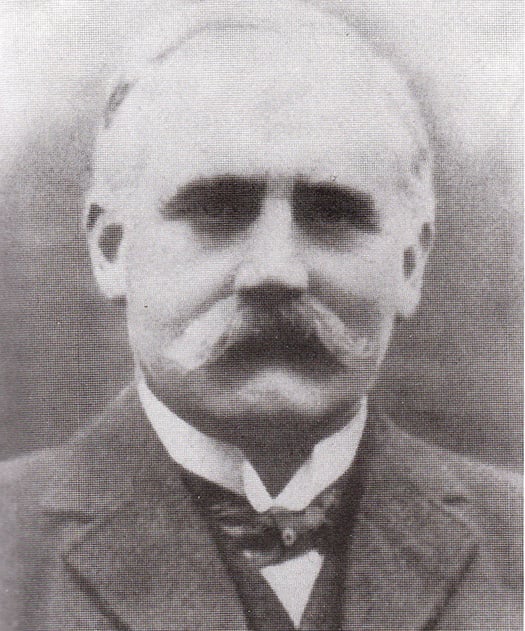
Thomas Myles around the time he was President of the Royal College of Surgeons in Ireland
But his opponent, one Dr Henry FitzGibbon, refused to accept the situation on the grounds that Myles' public involvement with the United Irish League would bring disrepute upon the college, and he went to court to argue his case that Myles shouldn't be allowed to stand for election in the first place .
Now it so happened that another keen sailing man, Walter Boyd of Howth (his son was to design the Howth 17s), was the judge who heard the case. Boyd is best known for his twelve years as a bankruptcy judge which resulted in the phrase "breaking Boyd's heart" becoming Dublinese to describe profligacy as referenced in Joyce's Ulysses. But in 1897 he had returned to more general cases, thus it was Boyd who heard the FitzGibbon/Myles case, and he threw out the plaintiff's arguments with such vigour that FitzGibbon was obliged to publish apologies and withdraw his candidature.
So when Thomas Myles became the president of the RCSI in 1900, it was an elevation which received much more than the usual attention around town. And in a style typical of the man, he set in motion the process whereby the College started to build itself the Grand Banqueting and Examination Hall, which is where the great and the good of Irish sailing were assembled yesterday.
The impressive new hall wasn't fully finished until 1904, but by that time its instigator had become Sir Thomas Myles Bt, as was the custom with retiring Presidents of the RCSI. Having seen the new building works under way, his retirement from office - though not from working as a surgeon - meant he'd more time on his hands, so he bought himself a great big ketch, the 121-ton Dorothy, which he cruised on the coasts of Europe.
But by 1910 or perhaps even earlier, he had downsized to the more workmanlike and manageable 60ft Chotah, which had been built in Brixham in Devon in the 1890s and was apparently not unlike a Brixham trawler, for the ever busy Wally McGuirk of Howth has discovered that she ended her days as an Arklow fishing boat.
The reason Wally and others are so interested in Chotah is that she is the missing link in the 1914 Howth and Kilcoole gun-runnings. We know all about the "flagship" of that event, Erskine and Molly Childers' Asgard, we know too about Conor O'Brien's ancient ketch Kelpie and have photos of her as well, and we even know a little bit about the Nugget, the McLaughlin family's boat which was the first fishing boat in Howth to be fitted with an engine.
But of the Chotah we know very little at the moment, but hope that the newfound Arklow connection will discover a photo. What is known is that when the gun-running committee sought to find a suitable vessel with auxiliary power to take over the cargo of 600 guns from Conor O'Brien's engineless Kelpie in order to land them on the beach at Kilcoole in County Wicklow, that pillar of society Sir Thomas Myles willingly agreed to bring Chotah in on the action. He and his crew took aboard the guns off St Tudwal's Island just south of Abersoch on the Welsh coast, and brought them across Channel to land at Kilcoole a few days after Asgard had made her much more high profile landing at Howth.
If you find all this insurgency activity by significant figures in Irish society a bit bewildering to comprehend in all its complexity, you ain't heard nothing yet. The Great War broke out just a few days later, and in a general mobilization Sir Thomas Myles Bt was soon appointed to being a Lieutenant Colonel in the British Army in order that he could head up a large Royal Army Medical Corps medical and surgery unit in his hospitals and in the field.
Then in November 1914 – barely three months after he had been personally involved in smuggling guns into Ireland while evading the surveillance of His Majesty's Armed Services – Sir Thomas Myles was appointed Honorary Surgeon to King George V. Yet it's said that when the 1916 Easter Rising took place, he readily found the facilities to treat any wounded rebels, and even managed to hide those on the run in the rabbit warrens of hundreds of rooms which were to be found in the great Dublin hospitals under his supervision.
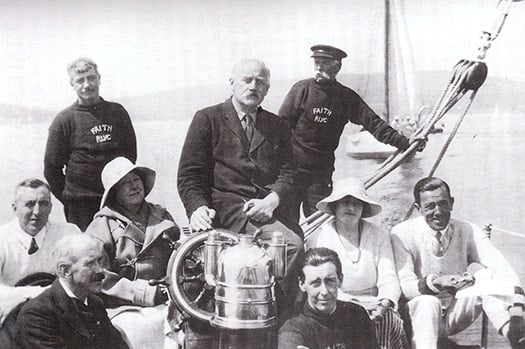
Pillar of society. Sir Thomas Myles sailing with family and friends aboard his cutter Faith in the 1920s. Photo courtesy RIYC
So if you happened to notice me looking around in some wonderment at the stately and ordered design of the Banquetting Hall in the Royal College of Surgeons yesterday afternoon while I reflected on the man who had caused this very fine room and the handsome edifice about it to be built, now maybe you'll understand why. Yet such is the complexity of Irish sailing in its myriad of forms that it's arguably all of a piece with the extraordinary lifepath of people like Sir Thomas Myles, and the ISA President's speech captured some of the problems people face in trying to administer this weird sport of ours.
The new Sailor of the Year Anthony O'Leary wasn't present for the awards as he is currently in the midst of a long-planned sailing campaign in Florida. But for the actual handover, his place was well taken by his son Robert and RORC Commodore Michael Boyd, who was co-skipper of Quokka in the successful Commodore's Cup team.
Things could have become completely surreal as the President himself, David Lovergove, wasn't at the event as his flight home from America the day before had been cancelled because of exceptionally heavy snowfalls on the US East Coast. But ISA Board Member David O'Brien of Cork of gallantly stepped up to the plate to fulfill the Presidential role, and made a fine job of delivering a speech which well encapsulates what the day was all about:
"Flag Officers, distinguished guests and fellow sailors, you are all very welcome here this afternoon. In looking out over this friendly assembly - some of whom I know very well, many of whom I know quite well, and some of whom I don't know at all but am looking forward very much to meeting – it is clearly obvious that the sailing and boating community in Ireland is one of enormous diversity.
In fact, in thinking of the sheer range and varying levels of activities afloat which we in the ISA try to represent, I am reminded of President de Gaulle's exasperated comment about the difficulties inherent in trying to govern France: "How can you administer a country" demanded the frustrated General "which has two hundred and forty-six varieties of cheese?"
Our fellow members of the Irish sailing and boating community may well think that we on the Board of the Irish Sailing Association tend to see ourselves as the big cheeses among the many varieties. Believe me, nothing could be further from the truth. Like yourselves, we could be described as the small artisan cheeses of sailing, with a strong local flavour. But it happens that it has fallen to us on the Board at this time, to undertake the task of re-shaping the Irish Sailing Association as it emerges rather bruised from the economic recession, and we need your help.
So I would ask you to be sympathetic to us in the administration of the Irish Sailing Association as we work to re-form our structures and implement our new Strategic Plan 2015-2020. It has been most encouraging the way that the Public Consultation Meetings in Dun Laoghaire, Cork and Galway in recent weeks have been so well attended, and from them we have gained very useful insights to work with you towards a productive, worthwhile and groundbreaking ISA Annual General Meeting on March 28th.
But that's another day's work. This afternoon, we are here for a celebration to honour Irish sailing and its many successes both individually and in team efforts through 2014. This function began as a thought in my mind when, during last summer, we were getting reports of fantastic results being achieved by Irish sailors and I felt that we, as the Board of the ISA, should recognize these achievements in some way. A reception was considered, then as Summer progressed and incredible achievements continued to roll in, I realized that such receptions would almost need to be held on a weekly basis.
So it was decided to wait until year end and combine the celebration of Irish sailing achievements with the presenting of the awards. Yet even that is a cause of concern. You see, in looking over the extraordinary listings for 2014, for the life of me I don't see how 2015 can even begin to match it. But as with 2014, doubtless this year will also produce some very welcome good news stories, and we look forward to the new season very much indeed, with the confidence that Ireland will continue to punch well above its weight in the world of sailing.
The structure of this afternoon's awards ceremony will help you to form a comprehensive picture of the entire Irish sailing and boating scene. Most appropriately, we will begin with the award for the ISA Training Centre of the Year, which we reckon to have been the best in 2014 from a lineup which includes an impressive 80 training facilities, run both in clubs, and as commercial ventures.
It's also worth noting that there are now 24 secondary schools in Ireland, which include sailing as a sports option in their curriculum. A while ago, I visited Schull Sailing School and was bowled over by the fact that the children in the local school select sailing as their sport of first choice, ahead of rugby, soccer, Gaelic football, hurling, hockey etc. Now that is some achievement. This is clearly a step in the right direction, and it leads us to the next part of our ceremony, the award for the ISA Youth Sailor of the Year.
Having laid the foundations, so to speak, we then move on to the announcement of the ISA/Mitsubishi Motors "Sailing Club of the Year" award. The demographics and population spread of Ireland are such that our sailing clubs play the key role in most of our sailing development, and as we had the world's first sailing club in 1720, our clubs are literally world class.
We not only invented sailing clubs, but back in 1979 we became the first sailing country in the world to have an informal "Club of the Year" competition. Since 1986, it has been sponsored by our very good friends of Irish sailing at Mitsubishi Motors.
We feel that today's national gathering is the appropriate time to announce the winner, which will be known as the Sailing Club of the Year 2015. But in time-honoured tradition, as the new season gathers pace, there will be another ceremony in the winning clubhouse for the full and final handover of the historic ship's wheel trophy, when the members can share in the successes obtained by their top competitors and administrators.
With this framework of Irish sailing clearly in place, we then conclude with the peak of achievement, the ISA/Afloat "Sailor of the Year 2014". Afloat's ownership of this award – based on Sailor of the Month winners - has a long history, going back to 1996, and it successfully highlights achievement in every area of sailing.
One month, you might get an exceptional voyage honoured, while the next month it might be a major international dinghy championship victory. The diversity is total. And just occasionally, to emphasise that we are a community, which functions afloat and ashore, the monthly award might go to someone who has given selflessly of their time for sailing administration.
The overall national award will be presented to the person who, in the judges' opinion, achieved the most notable results in, or made the most significant contribution to Irish sailing during 2014.
The boating public has had a chance to nominate their top three through an online poll, Afloat.ie got a vote too and the Sailor of the Year judges have decided the final winner.
I cannot conclude without acknowledging our sponsors. In addition to those mentioned here today – Dublin Port, Parasol and Mitsubishi Motors - I also want to thank Providence Resources for their contribution to the high performance squad. However, it is the incredible support that we receive from the Irish Sports Council that allows us to function and without whose support we would not have nearly as much to celebrate today as we have. Year after year the Sports Council continues to support sailing and behalf of Irish sailors, I thank you most sincerely".
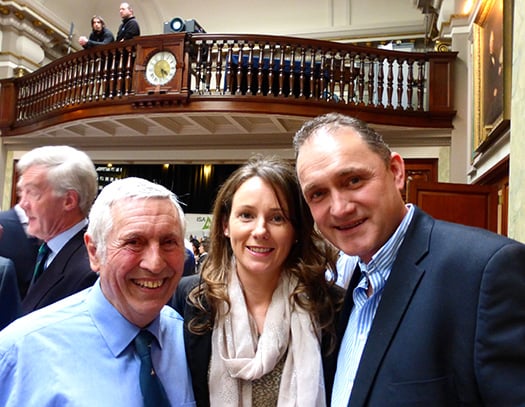
The men who raced the open ocean. At the reception in the RCSI were (left to right) Dickie Gomes (Sailor of the Month for May 2014), Caroline Coyne, and her husband Liam Coyne (Sailor of the Month for August 2014). Both Dickie and Liam have sailed short-handed Round Britain and Ireland Races with success, the former in 1982 and the latter in 2014. Liam Coyne topped the Afloat.ie online poll for 2014. Photo: W M Nixon
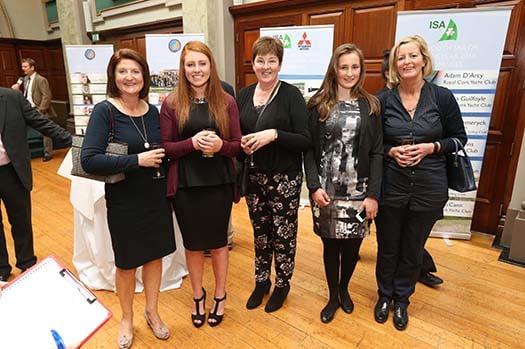
Josephine Keller, Aisling Keller, Ann Carroll, Nicole Hemeryck and Oisine Hemeryck
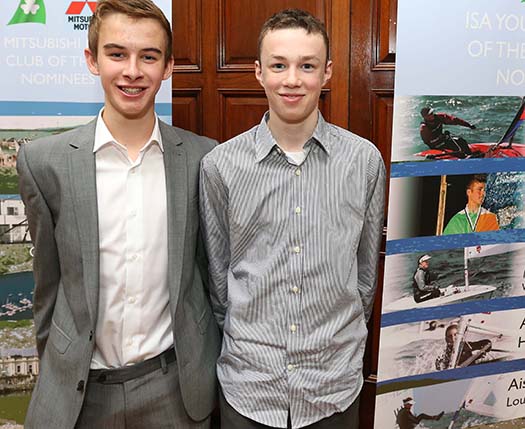
Conor Quinn and Adam D'Arcy

Pat O'Neill and Charles Seargent
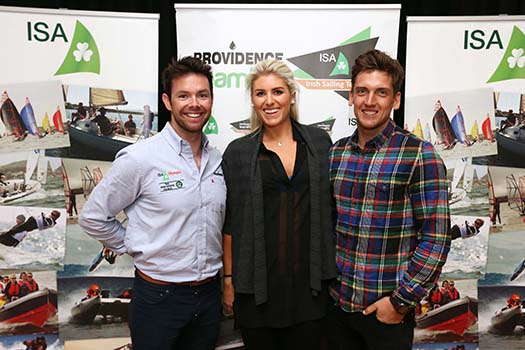
Matt McGovern, Ryan Seaton and Saskia Tidey
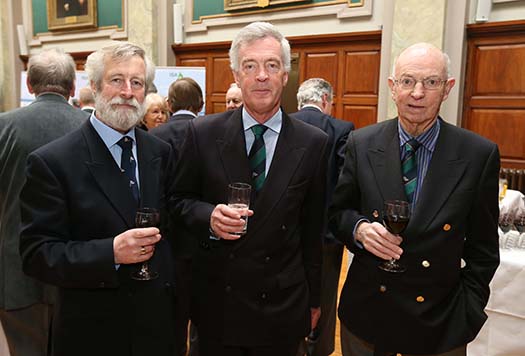
Charles Sargent, Brian Craig and Paddy O'Neill

Jack Roy, David Vinnell, and Ron Hutchieson
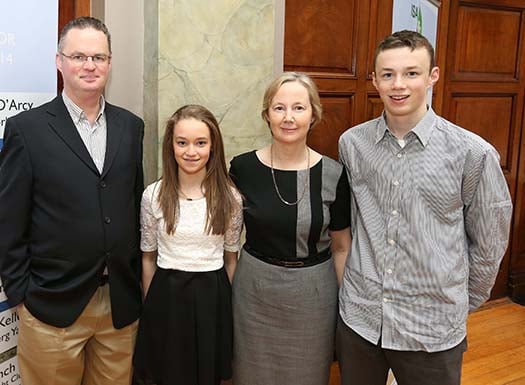
John D'Arcy, Kate D'Arcy, Imelda D'Arcy and Adam D'Arcy
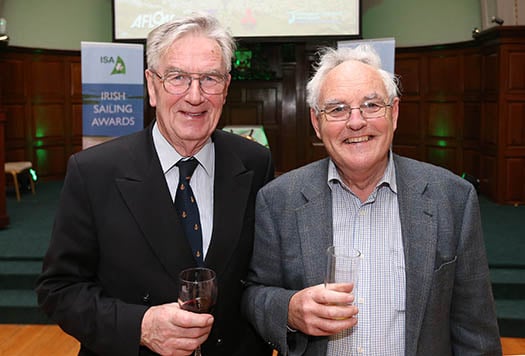
Hal Bleakley and Padraic O Brolchain

Ian Dickson, Andy Johnston, Jim Lampkin and Jane Johnston
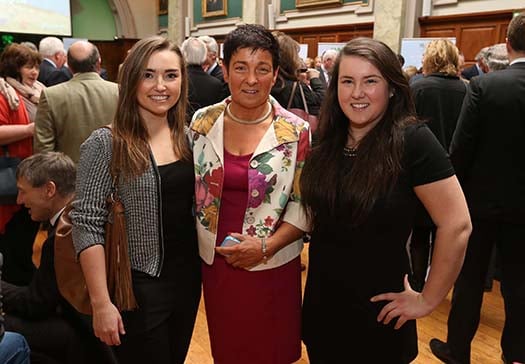
Isabella Morehead, Claire Burke and Muireann Guifoyle

Tony O'Driscoll and David Metcalfe
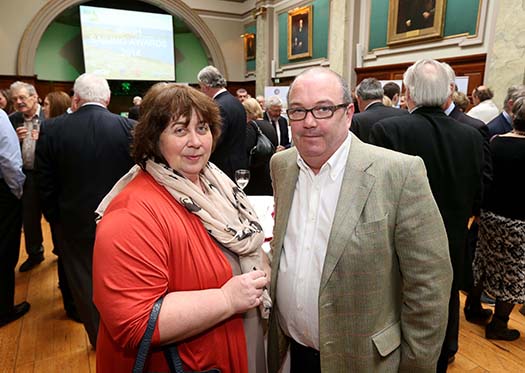
Sandra Wynne and Edwin Fay
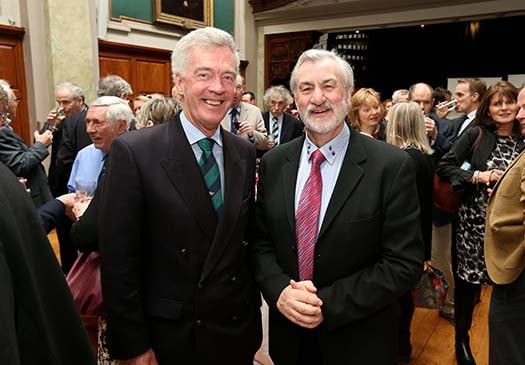
Brian Craig and Kieran Mulvey, Chairman, Irish Sports Council
#soy – The new stars of the Irish sailing firmament are Anthony O'Leary (57) of Cork and the successful Commodore's Cup team. In a gala ceremony in Dublin this afternoon to celebrate the many achievements of our sailors in 2014, O'Leary and his team mates were applauded as the crème de a crème, reflecting his own insistence throughout the exemplary Commodore's campaign that it was only by a close-knit group effort that success could be obtained.
The sharing of the award - presented in a crowded gathering of Ireland's diverse sailing community in the Royal College of Surgeons by Minister for the Marine Simon Coveney on behalf of the Irish Sailing Association and Afloat.ie - proved to be doubly appropriate, as O'Leary himself could not be present owing to a longterm commitment to a week-long sailing campaign currently under way in Florida.
However, his son Rob – a former Sailor of the Month himself - accepted the Afloat.ie Sailor of the Month award for June 2014 on his father's behalf. That award was to celebrate Anthony O'Leary's success in being the overall winner of the British Open IRC Championship.
But after that, his personal achievements continued at a high level throughout the season, as he became the Helmsmans Champion 2014 early in September racing with the J/80s in Howth, and then later that same month he won through to be the 1720 National Champion racing in Baltimore.
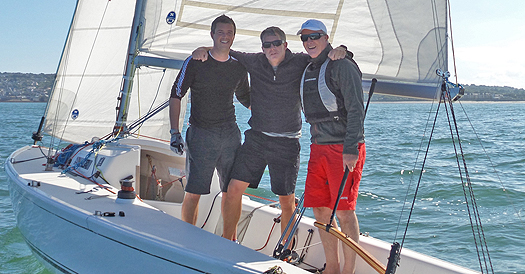
Anthony O'Leary (right) and his crew Dylan Gannon (left) and Dan O'Grady celebrate All Ireland victory off Howth in the Helmsmans Champs. Photo: Jonathan Wormald
That this all occurred within weeks of his brilliant leading of the Commodore's Cup team during the last week of July gives some indication of the enormous contribution made by Anthony O'Leary to Irish sailing during 2014.
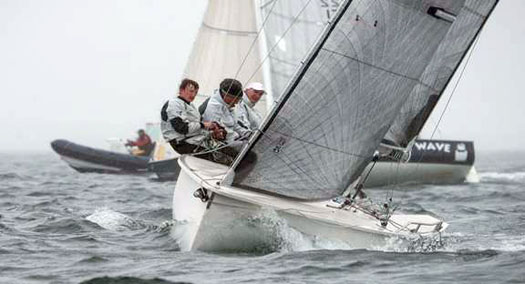
1720 National Champions – Anthony O'Leary's Antix crew in winning form again off Baltimore. Photo: Aedan Coffey
But as the Commodore's Cup win also saw the Afloat.ie International Award for July being made to the entire team, the Sailor of the Year 2014 was jointly presented to Rob O'Leary standing in for his father, and to Michael Boyd, recently elected Commodore of the Royal Ocean Racing Club, who was one of the Irish skippers in the superb Commodore's Cup team.
It is the second time the Crosshaven skipper has won the Irish Sailor of the Year title, he lifted it first in 2010.
Boating Visitors To Ireland's South Coast Get Mixed Welcome Messages
#marinetourism – Ireland's south coast provides an almost infinite variety of harbours, natural havens, and extensive areas of interesting sailing water. These cater for boat enthusiasts of all kinds, with craft of every type. So how does the welcome for visitors shape up? W M Nixon contrasts the different hospitality styles of four attractive ports.
The word on the grapevine that the Ballydehob Old Boat festival had taken place arrived with an intriguing photo from Anthony O'Leary. It had been noted in the interview with him immediately after he had led the team in Ireland's Commodore Cup Victory, that while he was trying to unwind for a while, it's not really in the O'Leary makeup to relax, and soon his mind was busy with new ideas of nautical interest.
Nevertheless he was cruising gently in early August down towards West Cork in the family's handsome big Nelson powercruiser Irish Mist, a fast and able vessel which his father Archie and mates like Mick Ahern once took right round Ireland in a settled springtime spell of weather, just to be in Dublin to watch Cork Con play rugby in some major championship at Lansdowne Road.
As it turned out, this year Irish Mist was getting down west ultimately to be in Baltimore for the 1720 Nationals in late August, which O'Leary duly won. But from time to time, he flashed back some photos of interesting boats met along the way, and one which really rang the bell was a little Ette Class clinker-built gunter-rigged sloop sailing in Castlehaven.
The Ette class originated way way back, when two keen dinghy cruising types sailed their little dinghy into Castlehaven, and the Castletownshend locals in the South Cork Sailing Club were so taken by the boat that they commissioned the waterfront boatbuilders, the O'Mahony brothers, to build some sister ships as the basis of a class.
All the new boats' names ended in "ette". And the class survived for many years, though at times the Ettes were hanging on by a thread. But recently it has had a fresh lease of life with new examples of what is now a classic dinghy being built by Lui Ferreira of Ballydehob, who last came through this parish when, in 2012, he put the first teak deck on a vintage Howth 17, the syndicate-owned Deilginis.
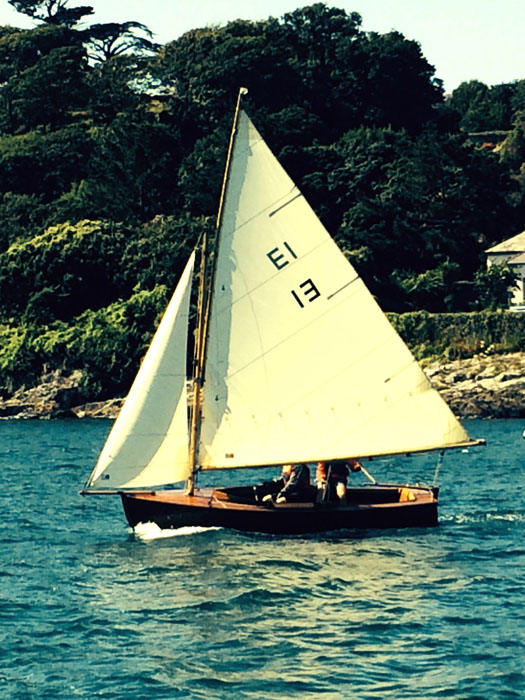
Perfection of summer – an Ette class in her home waters of Castlehaven. Photo: Anthony O'Leary
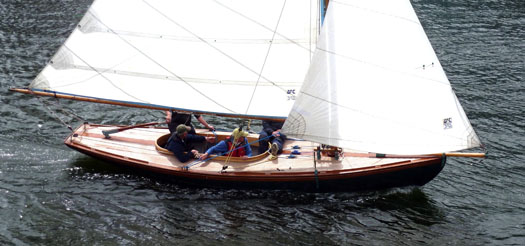 Rui Ferreira, builder in Ballydehob of the Ette Class, also put this teak deck on the 107-year-old Howth 17 Deilginis in 2012. Photo: W M Nixon
Rui Ferreira, builder in Ballydehob of the Ette Class, also put this teak deck on the 107-year-old Howth 17 Deilginis in 2012. Photo: W M Nixon
A Howth 17 looks well no matter how you photo her. But an Ette is a quirky little thing which can sometimes look odd from the wrong angle. Yet in a flash of inspiration, the Captain of the Commodore's Cup team took up his iPhone as an Ette came bustling down Castlehaven on fine sunny morning, and we got what I reckon to be one of the best photos of an Ette under way ever obtained – plus it gets the very essence of summer in Castlehaven.
The next O'Leary snap some days later was just briefly titled: "The Ballydehob Old Boat Festival, Irish Mist in archway second left". What was going on here? We'd heard vague stories about a very relaxed assembling of boat at high water at the drying quay at Ballydehob, but the O'Leary photo hinted at serious numbers and a high level of organization.

The teaser photo – first intimations of this year's Ballydehob Gathering of the Boats, with the O'Leary family's motor-cruiser Irish Mist (framed in the second arch from left) joining an eclectic group of 74 boats for a couple of hours at top of the tide. Photo; Anthony O'Leary
 This is most people's image of Ballydehob, crowded and very rural, with Mount Gabriel beyond. Only the more observant will notice the tidal river in the foreground. Photo: W M Nixon
This is most people's image of Ballydehob, crowded and very rural, with Mount Gabriel beyond. Only the more observant will notice the tidal river in the foreground. Photo: W M Nixon
To begin with, most casual visitors would scarcely think of Ballydehob as a seaport at all. Rather, it's the very essence of rural West Cork, a crowded little village where "laid-back" is the default mode, and it has been so for some time. It reached something of an apotheosis when Annie Barry (she's one of the Fergusons of Gubbeen Cheese) was running her wonderful Annie's restaurant on one side of the winding main street, and the Levis sisters Julia and Nell, feisty little ladies of mature years, were running Levis's pub across the way.
Julia and Nan were splendid folk of considerable standing, and it's said the pair of them were once squired to the West Cork Hunt Ball in Skibbereen by Jeremy Irons of Kilcoe Castle a few miles along the coast. As for the setup in Ballydehob, space was so limited in the restaurant that, having checked out your booking, you simply took up station in leisurely style across the street in the pub with Annie's menus and an aperitif or two, then Annie would come across the road and discuss your order, and a delightful evening would continue late into the night.
Alas, for some year now Annie's has been closed, though everyone lives in hope of somebody re-opening it. And in the pub, the old ladies have passed on. But now it's run by a great-nephew, and very successfully too. We got ourselves in there late on a velvet July evening this year to find the place was heaving with youth and beauty and high fashion in casual style - achingly trendy it has become.
It could have been a traditional local in any of the world's fashionable holiday areas except for one thing. A ball of fur, a terrier of some kind, emerged from among people's legs and barked its head off at me. I assumed it was because I carried a whiff of our own little Jack Russell. But the blushing girl owner told me with a big smile that her little dog must have thought I was a priest. Only along Ireland's south coast, near some former or still surviving Protestant enclave, would you have heard that particular excuse.
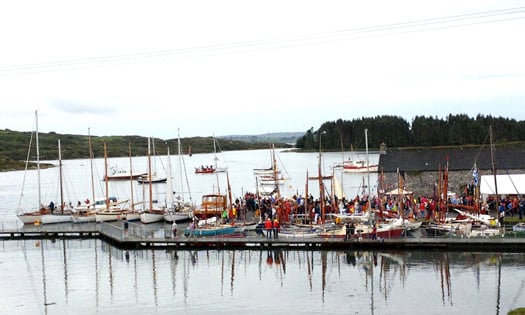 The old dock at Ballydehob is well able to receive a very varied fleet, seen here from the old railway viaduct Photo: Miriam Jones
The old dock at Ballydehob is well able to receive a very varied fleet, seen here from the old railway viaduct Photo: Miriam Jones
Just along the river from these scenes of hospitality and minor mayhem, immediately below the mighty railway viaduct which seems to be so disproportionate for the long-gone needs of the little West Cork Railway, there's Ballydehob Harbour. Time was when it was key to the place's economy, and it was in the late 1930s, only a year or so before World War II, that the Brooklands, the last surviving sail-only coasting schooner to deliver cargoes to West Cork, made her way up the winding estuary at the head of Roaringwater Bay (it's named for the Roaringwater River, much of the bay behind Carbery's Hundred Isles is well sheltered), to anchor just off the quay, as she was too deep to berth alongside.
The Brooklands was owned and skippered by Tom Creenan of Ballinacurra in the inner northeast reaches of Cork Harbour, but it was from Birkenhead or Goole on the Mersey that she'd bring her welcome cargoes of coal, a challenging passage at the best of times. At Ballydehob, while smaller cargo-carriers could get alongside the old quay, the Brooklands discharged her cargo into the multi-functional barge-type vessel known the Sandboat.
She was used by her owners, the Levis family, for just about everything, but primarily for going out among the islands towards high water, running up on a clean beach, then laboriously shovelling sand into the hold until the tide returned and the Sandboat could be floated off and piloted back to the quay where her eventually very useful cargo would be shovelled ashore to become builders' supplies.
The Sandboat was Queen of the Fleet at Ballydehob, and she played such a central role in the Levis family's life that Old Boat Festival organiser Cormac Levis's brother calls his pub in Ballydehob the Sandboat.
As for how Cormac himelf first got the notion for the Ballydehob Gathering of the Boats, he has been a tower of strength in the Traditional Boat movement, particularly in West Cork but also throughout Ireland, for many years. And with others following his example in restoring or even building new sailing lobster boats to traditional design, he suggested that getting together at Ballydehob during the little town's time-honoured summer festival around August 15th might hit the spot. And for the first one in 2004 –making this year's the tenth anniversary - they assembled nine boats, which was considered pretty good going.
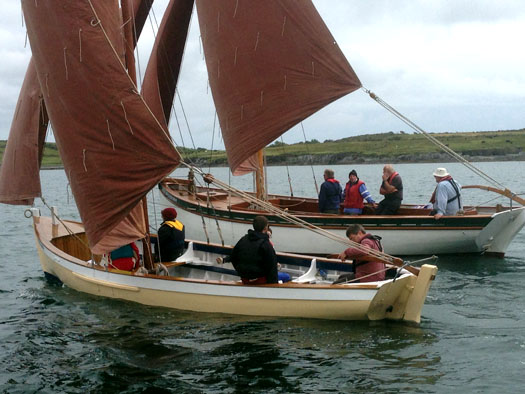
Close-up on Cormac Levis's lobster boat, which led the way for the first gathering of traditional craft at Ballydehob in 2004. Photo: Brian Marten
From it, they learnt that, for the future, while the aspiration would of course be for quiet and easy-going organization under a light hand, underneath it all there'd have to be efficiency, always with an eye on the clock. Although the tidal window is more than two hours for most boats, they've successfully accommodated modern yachts up to two metres draft without anyone being left behind stuck on the mud. But with limited manoeuvring space in both the harbour area and the channel, once the witching hour of high water is upon the fleet, it's time to start thinking about an orderly departure after two solid hours and more of good crack, mighty barbecues, and much interest in an examination of other people's traditional and classic boats.

Even among the sister-ships of the lobster fleet, many individual variants in hull lines and rig are apparent. Photo: Brian Marten

Just to add to the variety and colour, the Ilen Trust from Limerick brought their much-travelled Shannon Gandelows (right) to Ballydehob. Their stylish pennants are a legacy of heir successful visit to Venice at the end of April this year. Photo: Gary MacMahon
So the crucial thing is to select the ideal Saturday nearest to August 15th with a good big tide in mid-afternoon. As the Boat Gathering is such a force in its own right, they can range quite extensively on either side of August 15th, and to date the earliest has been August 8th, while the latest was August 21st.
This year's was Saturday August 9th, and while there may have been rain later in the day despite West Cork having much more sunshine in August than almost any other part of the country, no-body now remembers the rain as they recall the sheer fun and sense of community of what has been described by Tiernan Roe, another of the quality boat-builders of Ballydehob, as the "shortest bestest Boat Festival in the World".

Yet another creation of the active Ballydehob boat-building scene. This is an attractive little Cape Henry 21 cutter lunched in June by Tiernan Roe of Roe Boats. Photo: Tiernan Roe
For this year, it attracted 75 boats, though admittedly last year's record entry of 50 boats was greatly enhanced by this year's decision by the Drascome Lugger Association to combine Ballydehob in their 2014 cruise-in-company in West Cork, thereby adding 27 boats at a stroke.
But even with 27 boats of one class, the variety across the fleet as a whole was remarkable. So how do they assemble such a disparate fleet of boats with obviously highly-individual skippers, in such a quietly efficient way? For you'll never see or hear the Ballydehob Gathering of the Boats being publicly advertised all that much beforehand.
The method is perfectly simple. Everyone with an interest will know it is likely to be coming up on the agenda. So a month and more beforehand, Cormac will text them with the final date on a need-to-know basis. It works, and it sets the tone of quiet consideration for others and their boats in a very special festival in which some quiet sponsorship by CH Marine and West Cork-based German traditional boat fan Thomas Drewes sees that all participants get mementoes including cherished T-shirts (definitely not for general release), while barbecue facilities keep the good humour buzzing until everyone departs in style for their anchorage for the night, for although most boats hope to be berthed in Ballydehob on the big day more two hours hours before high water, once the ebb has started the channel has become much less forgiving about any pilotage errors.
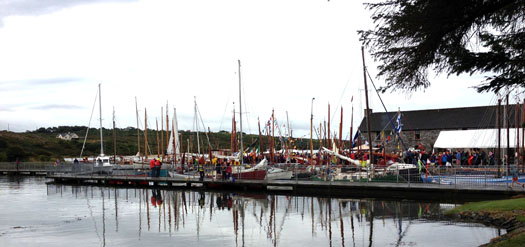
They're all here, as neatly berthed as you could please, but getting them away as the ebb starts requires good seamanship and boat-handling skills. Photo: Miriam Jones
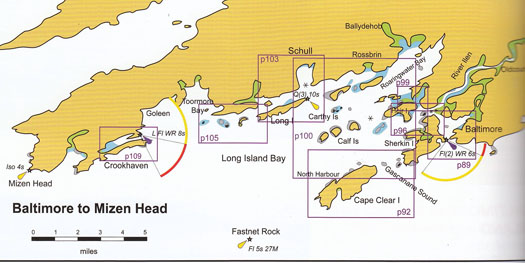
Ballydehob's central position in a hugely varied and welcoming crusing coast is emphasized by the number of other harbour chartlets indicated in this plan of the prime cruising area of West Cork. Plan Courtesy Irish Cruising Club
It's good to see a locally-focussed event like this now coming of age with a very healthy turnout. Eastward along the south coast, last weekend saw another event which will surely grow in stature and numbers, the second staging of Y2V Cruise-in-Company on the River Blackwater up the estuary from East Cork to West Waterford, as a flotilla of ten boats - eight GP14s, a Mermaid and a Feva – sailed up-river from Youghal to Villierstown.
It has been promoted by Youghal schoolboy GP 14 skipper Adrian Lee, and last year the inaugural tiny flotilla managed most of the sailable river by going to the bridge at Cappoquin before returning downriver to Villierstown. This year it achieved deserved support from the GP 14 class, with the furthest road-trailed from sea level being incoming Irish GP 14 Association President Stephen Boyle from Sutton DC, while the furthest-travelled in terms of elevation above sea level were the Blessington group, who came down from the Wicklow Hills with their Geeps and included Richard Street and kids (see again this blog on 26th July), and a brand new Duffin boat belonging to Simon Culley and Libby Tierney.
As for seniority, the classic of the class was a 60-year-old beautifully-restored Bell Woodworking GP 14 owned and skippered by 16-year-old Jack Nolan, another of that group of Youghal youngsters who are taking local dinghy sailing forward with gusto, while further variety was provided by Norman Lee of Greystones, his crew including the inevitable family pooches which are such a part of the GP 14 scene.
The sailing was mixed – as Norman said, in a river the wind will always be ahead some time, and though we think of the secret Blackwater Estuary as being fairly straight, in fact there are some quite significant curves. It took about four-and-a-half hours to sail up, and a brisker four hours to return on Sunday morning's ebb.
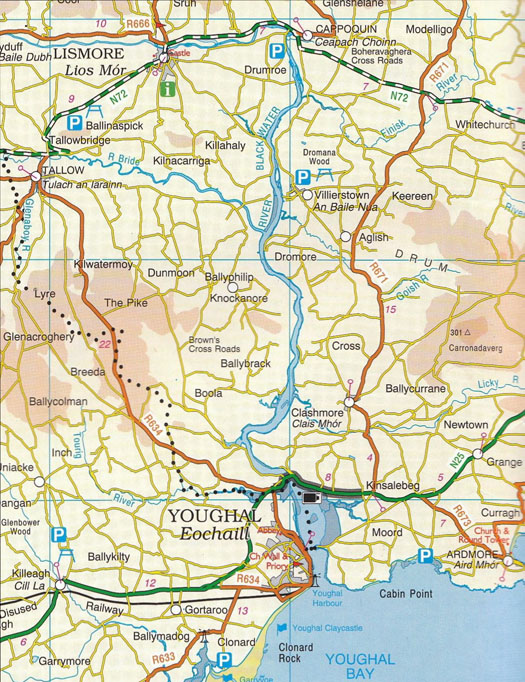
The secret waterway – the Blackwater Estuary from Youghal up to Cappoquin and almost to Lismore is one of Ireland's least-sailed rivers

Villierstown's new clubhouse, open only three weeks, was ready and willing to make welcome the crews who had sailed up from Youghal. Photo: Norman Lee

The new facility, Villierstown's "floating pier"
(right), was originally the in-harbour pontoon at Dungarvan SC. Photo: Norman Lee
At Villierstown, the new clubhouse of the Villierstown Boating & Activites Cub had been open only three short weeks, but they've made good use of a sports council grant, and it well fulfills a multi-purpose role, including providing the hospitality needed by sailing campers, with Paul Virtue and his wife Caroline organising a fine feast in the clubhouse on the Saturday night, and an enormous breakfast on Sunday to send them on their way downriver to round out an event which has future annual success written all over it.
One of the reasons it all went so well was that the slightly cogglesome little plastic floating jetty, along which the sailors of Villierstown used to access their small boats, has been replaced by a proper pontoon which the club acquired when Dungarvan SC eastward along the coast up-graded their in-harbour pontoon. In fact, Dungarvan support for the development of Blackwater sailing didn't stop there, as one of the fleet in the Y2V was a vintage Dungarvan-based Mermaid in which owner Eugene Burke has cruised the entire south coast between Ballycotton and Kilmore Quay.
The boat is Akita, Mermaid No. 85, and she has certainly been around, as she was built in the Barkyard in Skerries in 1953 by Joe and Matt Boylan. The Barkyard was originally the place where the Skerries-based coasting schooners and fishing boats had their sails preserved against rot by tanning with bark, but in the 1950s the now redundant premises were used to build some of the eventually enormous fleet of Skerries Mermaids through a boat-building class run by the colourful Jem Kearney.
The Fingal region around Skerries and Rush continues to be the great heartland of the Mermaids, with some very racy boats built in the old mill at Rogerstown recently, but despite the modern challenge, this year's Mermaid Week at Rush saw the champion emerge in the form of Jonathan O'Rourke of the National YC with his vintage boat, one of the few Mermaid sailors still in Dun Laoghaire.

The welcoming port. Despite its tidal limitations, Dungarvan lays on the welcome in a big way. This shows a visiting fleet at the original pontoon, which has now been moved to Villierstown. Photo Kevin Dwyer, courtesy Irish Cruising Club
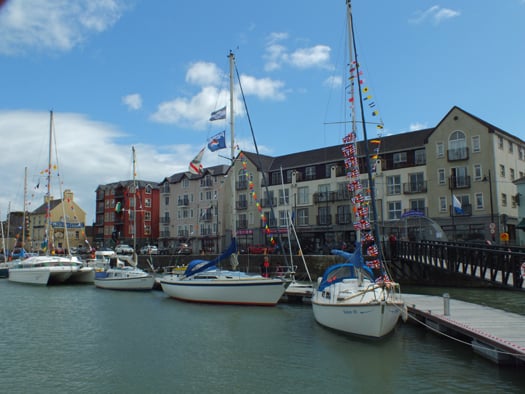
Dungarvan SC's new in-harbour pontoon has much improved the alongside berthing space, but unfortunately the local Council wouldn't permit dredging to improve access.......Photo: Donal Walsh

....and thus the reality for most boats in the Inner Harbour is a drying berth.......... Photo: W M Nixon
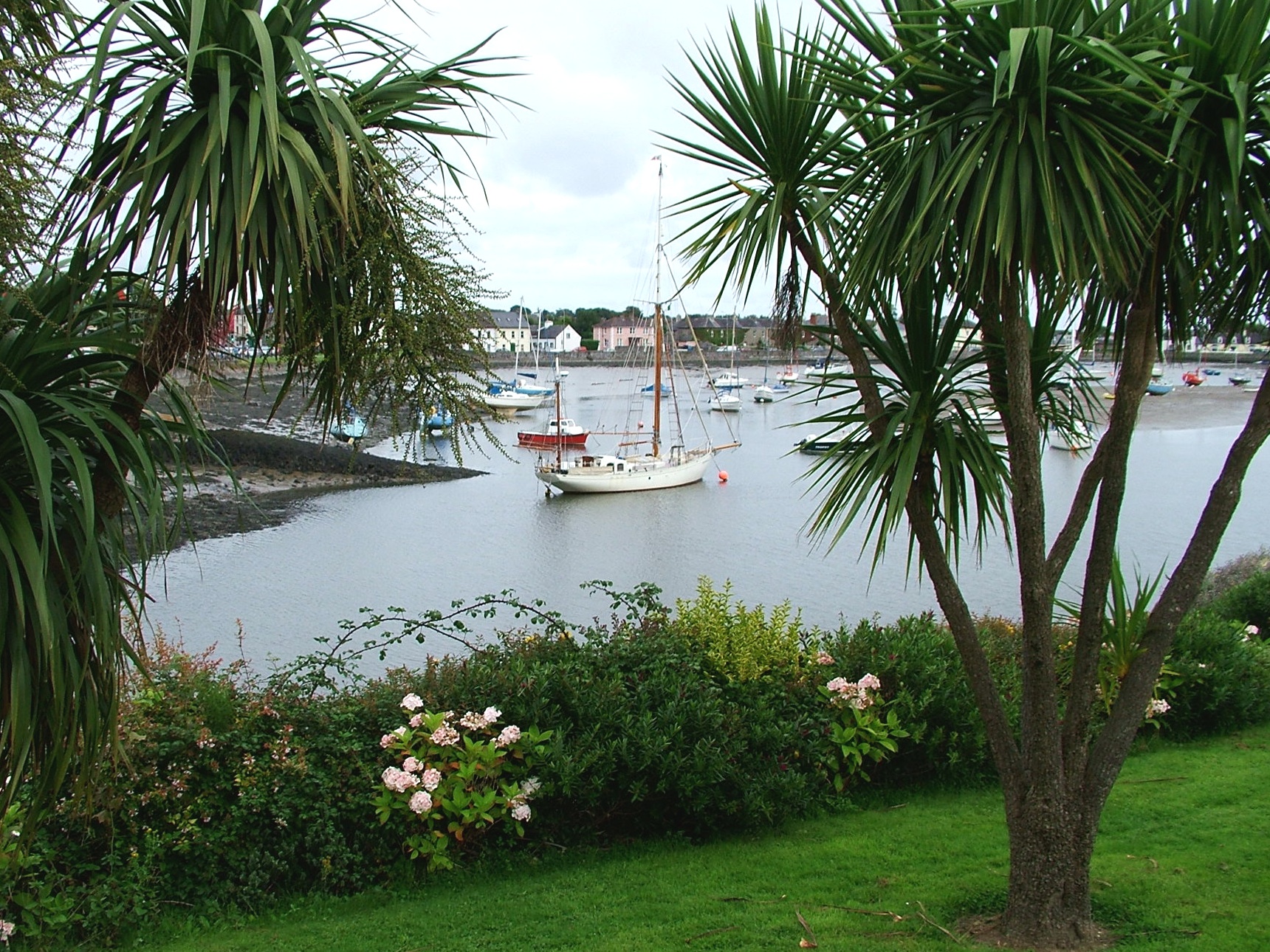
....but if you've access to local knowledge, there is a deep pool just below the bridge........Photo: Donal Walsh
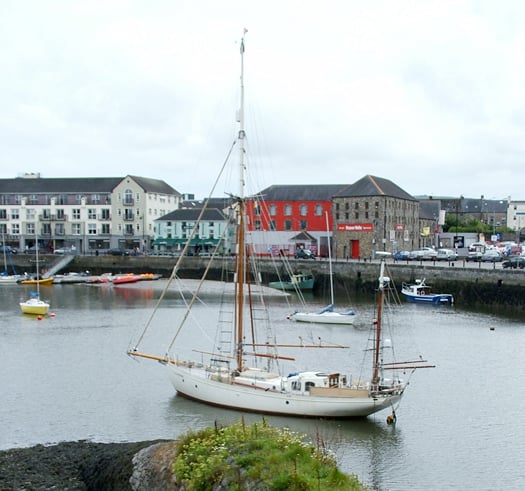
.....and here the Northwest Passage transiting 44ft steel gaff yawl Young Larry is visiting in comfort and style. Photo: Donal Walsh
Meanwhile in Dungarvan the club's hopes of doing a bit of dredging to improve access to their extended in-harbour pontoon was stymied when the council said they wouldn't permit any salt-contaminated sludge being brought up onto the quay. But despite its tidl limitations, it's a hugely hospitable place, and if you do take the ground at the pontoon, it's mostly soft and forgiving mud which enables you to sit in relative comfort. Certainly some very substantial cruising boat have overnighted here to enjoy the fine pubs both on the waterfront waterfront and in the town, while culinary standards are set by Paul Flynn's famous restaurant The Tannery just round the corner.
Nevertheless if you absolutely won't let your boat dry out, leading Dungarvan cruising man Donal Walsh (he has just returned from an epic round Ireland and Britain clockwise cruise with his Moody 31 Lady Kate) well knows the deep pool across the harbour close under the bridge, and he saw to it that his brother-in-law Andrew Wilkes and sister Maire Breathnaith found a secure berth there for their hefty 44ft steel-built gaff yawl Young Larry, a boat in which they transited the Northwest Passage, but she looks well at home in Dungarvan with its fine tradition of first class locally-based trading schooners.
In moving along the south coast, we find that when possible, they'll lay out the welcome mat big-time in Ballydehob, Youghal, Villierstown and Dungarvan, despite the fact that all four places are restricted in what they can do by the exigencies of tide.
So how are things working out in Dunmore East, the one port which has the potential to be one of the most welcoming and accessible all-tide sailing and fishing ports along the entire south coast?
Despite this potential, the under-development of its facilities, fuelled by a sometimes poisonous attitude between fishermen and other harbour users, has provided recreational visitors with often unpleasant memories. In trying to understand why this might be so, we have to understand how Dunmore East came to get its pretty little harbour. When it was built in the first half of the 19th Century, it was not – as is commonly supposed – built for the benefit of fishermen. The horrible fact is that fishermen came so far down the pecking order that they just had to make do for themselves as best they could.
The handsome new pier at Dunmore East, designed by Alexander Nimmo who is best known for developing Tobermory in Scotland and many places in Galway including Roundstone, was constructed exclusively for the use of the new fast sailing cross-channel packet boats serving the top people of Waterford in their trading and communication with Britain, while the unfortunate local fishermen were forced to keep their boats in the limited shelter of The Cove to the north of it, and haul them on the exposed beaches at The Strand and Councillors Strand.
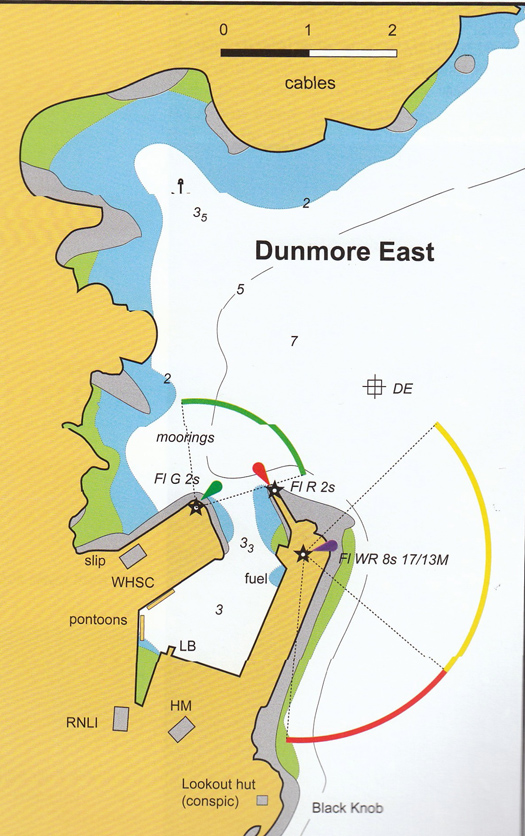
Dunmore East's substantial pier was new-built originally to provide a port for cross-channel sailing Packet Boats, serving Waterford ten miles up the road. When this was its primary function, any local fishermen were banished to the poorly-sheltered coves to the north, with their boats being hauled up on the exposed beaches beyond. Plan courtesy Irish Cruising Club
Soon, however, steam driven packet boats were able to go conveniently all the way up to Waterford, and Dunmore East was redundant as a packet-boat harbour. But it was only with reluctance that fishing boat were allowed to start using it, as the Royal Navy would have been keeping an eye on its possibilities for their own occasional use.
Yet down the years, the idea has developed that Dunmore East was always primarily a fishing harbour, and to a lesser extent the same attitude prevailed at Howth on the east coast, where the new harbour functioned as the Packet Boat station for Dublin only between 1817 and 1826, when the developing new asylum harbour at Dun Laoghaire became the selected port for the Royal Mail's new paddle steamers serving the cross-channel route. Yet the silted harbour at Howth was only allowed to become a "fishing station" in the 1850s.
The legacy of all this, in Dunmore East at any rate, is that there still seems to be a suspicion among the fishing community that their tenure is only temporary, that the powers-that-be would move them out if they see a better use for the place. How else can we explain the negative and almost paranoid attitude of the fishing spokesmen every time a suggestion for a much-needed marina at Dunmore East is put forward?
With all this in mind, I made a quick visit to Dunmore East in mid-August while on other business in the southeast, in the hope of seeing if a much-trumpeted €4 million dredging scheme was now in progress in the harbour, and also to see how an equally celebrated new Visitors Pontoon along the East Pier was working out.
The photos speak for themselves. There wasn't any sign of a dredger, though doubtless that will turn up in due course. Yet as for the 40 metre pontoon, it's not a leisure-boat-friendly neat little piece of work at all, but is quite a massive and brutal steel box structure more suited to rugged fishing boats, who were showing their approval by using it so totally that the only leisure visitor was a German motor-cruiser which had managed to squeeze in at one end.
But as this pontoon is on the wrong side of the harbour for ease of access to the Sailing Club on the west side, and the welcoming facilities in the village above it, any pedestrian boat visitor – the vast majority of incoming leisure boaters, in other words – has a long trek through the sometimes crowded and malodourous delights of a fishing port before they can access any amenities. So not surprisingly the German boat had its inflatable tender moored outside it for quick and easy movement across the harbour, and along to the beaches if wished, a situation which inevitably precluded any other newly-arrived boat from rafting up alongside
So for any cruising boat coming in from sea, often with the challenge of Hook Head just recently put astern, it wasn't a welcoming setup. In fact, it was downright hostile. While we were there, an ordinary sailing cruiser with happy folk aboard came motoring from the eastward to round the end of the pier after stowing their sails, but their hopes of a convenient and enjoyable visit to Dunmore East were soon dashed. No welcoming RIB came out from the sailing club to direct them to a vacant mooring, as there probably wasn't one. And as for the pontoon, "unwelcoming" is inadequate. It clearly didn't want anything to do with them. You could see their spirits wilting as they headed out, faced with the long haul up to the marina in Waterford City. The current visitor berthing situation in Dunmore East is at the very least a sad business, so where does it go from here?

Dunmore East in mid-August. No sign of any dredging, and the "Visitors Pontoon" under the lighthouse on the East Pier is packed out with fishing boats.......Photo: W M Nixon
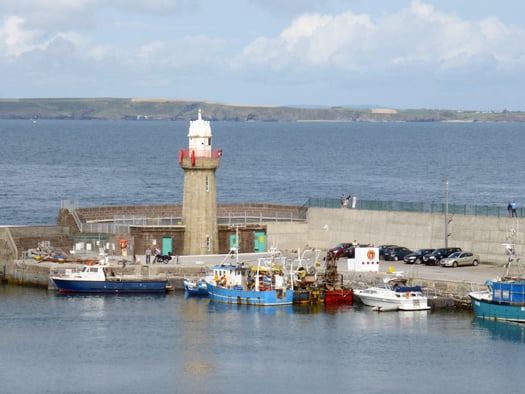
........and just one visiting German motor cruiser which was protected against any rafting up by its tender on the outer side. Photo: W M Nixon

The new pontoon is an industrial standard piece of kit......Photo: W M Nixon
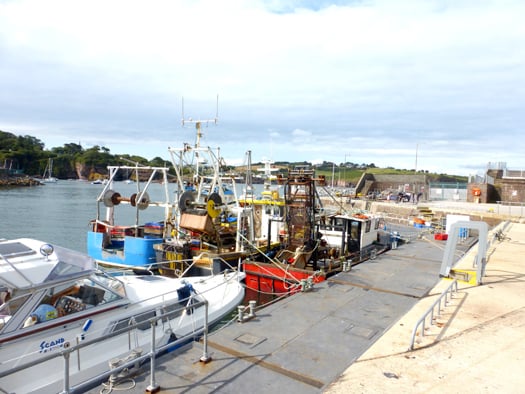
....and understandably very popular with active fishing boats. Photo: W M Nixon

But for visiting sailing boats newly arrived in port.......Photo: W M Nixon
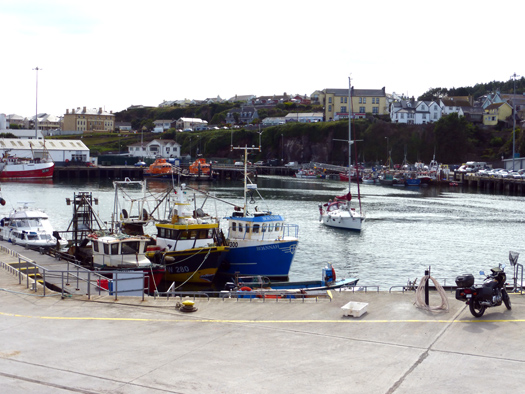
....it's soon clear that there isn't really a welcoming berth for them.....Photo: W M Nixon
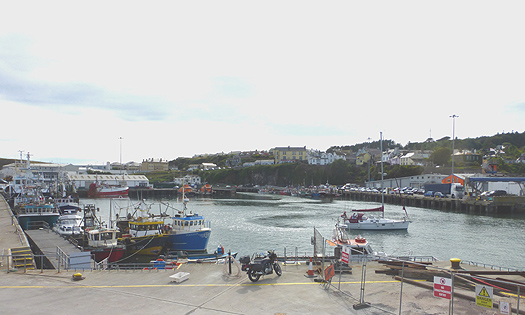
....and they head out to sea again, visibly disappointed by their Dunmore East welcome. Photo: W M Nixon
Ireland Extend Commodores' Cup Lead in Cowes
#rorcbdcc – Ireland's three boat Commodore's Cup team has taken a commanding lead on the Solent, leaving four British and four French teams in its wake. This afternoon, the Irish Cruiser Racing Association (ICRA) team extended it's lead to 99.5 points clear of GBR Red after three windward-leeward races.
Three windward-leeward courses were sailed in testing conditions and heat that reached 30 degrees celsius on The Solent. The breeze rarely exceeded 8 knots and an ebb tide of up to 2.5 knots crossed the course area.
Both Marc Glimcher's Catapult and Quokka 8 chartered by Michael Boyd and Niall Dowling had their best results to date with both crews scoring second places in the 27-strong fleet. Catapult has been engaged in a constant battle with rival Ker 40 Cutting Edge for Britain Red, the lowest scoring boat of the series so far.
While Ireland has a comfortable lead in the event that started on Sunday, two races remain in the schedule both of which have bonus points.
A race around the Isle of Wight is planned to start at 1000 tomorrow morning though doubts are widespread that this can be completed with a north-easterly airflow expected to create a wind-shadow to the south. A points multiplier of 1.5x applies to this race.
A short inshore race, probably a windward-leeward is planned for Saturday morning which is double-scoring to round off the event.
The four races sailed to date constitute a series in the event of weather preventing further racing, an important point give current forecasts.
Additional reporting from RORC
In contrast to the frustration of yesterday's two unfinished races, today three inshore races were successfully held at the Brewin Dolphin Commodores' Cup, bringing the Royal Ocean Racing Club's biennial flagship event for national teams with amateur crews back on schedule.
With five inshore races sailed Ireland has now established a solid lead of nearly 100 points, on 176 followed by GBR Red in second on 275.5 and with France Green and GBR Scotland jockeying for third place on 291.5 and 292.5 respectively. After today's second race just five points separated second from fifth place in the team rankings.
Principal Race Officer Stuart Childerley bravely set up a start line off Osborne Bay just to the east of Cowes for today's first windward-leeward race, sailed in a light northeasterly. Robert Lutener's Cutting Edge, sailing in GBR Red, nailed the start mid-line and found better pressure in the middle of the course to lead at the weather mark from American Marc Glimcher's Ker 40, Catapult, in the Irish team. In the light winds throughout the day it paid to be out in front in clear air and, in the first race, Cutting Edge managed to remain ahead of Catapult to win by 19 seconds on corrected with Eric de Turkheim's A13 Teasing Machine third for France Green.
Cutting Edge helmsman, Royal Yachting Association Chairman Stacey Clark, explained: "We managed to get off the start line in clear wind and were off and away. We've had some fantastic racing with Catapult, really close boat on boat stuff the whole time, but both of us conscious that we are IRC racing." With Figaro sailor and UK Match Racing Champion Nick Cherry calling tactics, Cutting Edge has been sailed well all week, demonstrating good tactics and boat handling, which Clark attributes to the long time the crew has been together - it originally came together 15 years ago for the Rolex Fastnet Race.
The second race was started in the same northeasterly wind, but saw a substantial right shift on the first upwind leg. In this it was the turn of GBR Scotland's big boat, James McGarry's Swan 45 Eala of Rhu to make her mark.
Tactician Kevin Sproul described it: "We had a good start and got clear immediately. There were some big shifts out there, but we got on to the first one and it was a nice one that gave us a jump on everybody else and from there we could sail our own race. The boat goes well downwind in the light stuff, which gave us a bigger lead. Then on the second upwind leg when they moved the mark, we thought it would pay to be right so it was made pretty easy for us. We didn't have too many decisions to make."
Eala of Rhu went on to win the race by more than two minutes from Michael Boyd and Niall Dowling's Grand Soleil 43, Quokka 8, sailing in the Irish team.
The race was unusual for having match racing-style starboard weather mark roundings. Stuart Childerley explained: "This was for a tidal offset. With an ebbing tide and a northeast wind, if we had stayed with the port rounding we would have had a very biased run. You couldn't do that with a one design fleet, but I think it provided better racing."
After race two the sea breeze filled in, killing the northeasterly, but the race management team hung on and the patient wait by the crews provided the opportunity for some alternative watersports including an impressive wakeboarding display (attached to the main halyard) behind Yeoman of Wight crew and some halyard swinging on Cobra and Fatjax.
After a catalogue of delays due to the arrival of ships in the Solent and wind shifts, plus three general recalls, a third race finally got off late in the afternoon once a southeasterly breeze had established. This final windward-leeward was claimed by France Green's Teasing Machine, finishing on the water behind yet another close match race between the two leading Ker 40s.
"We had a good start," explained Teasing Machine's owner, Eric de Turkheim. "We had a bad start on the second race and paid the price. Being a big boat you have the speed so if you can make a good start you are ahead and then it is a question of managing the pressure."
Tomorrow the classic course round the Isle of Wight is scheduled, one of the main attractions of the Brewin Dolphin Commodores' Cup, in particular for the visiting teams. However the forecast indicates this will provide a 'challenging day' for competitors. Kevin Sproul and the Eala of Rhu crew have experience of this from this year's light wind Round the Island Race which took them 10 hours to complete... "and we were nearly first home. It is a very similar forecast to tomorrow. I just don't see the point of us going around the back of the island if there is no breeze whatsoever and having a drift back, so I am a bit twitchy about that."
Given this prospect, leader of the Irish team, Anthony O'Leary is also twitchy. "We will need that 100 point lead if they send us around the Isle of Wight tomorrow. It could turn into a lottery." Ireland has previous experience in this event of being ahead and seeing victory slip through their fingers. O'Leary continues: "It may well be 100 points, but it is 40 points per boat tomorrow and even more on Saturday. But it is nice to be in that position, and we're there because of the team effort today which was just fantastic."
Team Name Team Points Team Place
Ireland 176 1
GBR Red 275.5 2
France Green 291.5 3
Scotland 292.5 4
France Blue 301 5
France Red 334 6
GBR White 342.5 7
France White 410.5 8
GBR Blue 411.5 9
#commodorescup – Royal Irish pair Michael Boyd and Niall Dowling from Dun Laoghaire have won the final "championship" weekend of the Warsash Spring Series in Hamble in Tarka with a 1,2,1,3,1,1 scoreline beating their rival Jim McGregor's "Premier Flair" who scored 2,1,2,1,3,2.
In addition, "Tarka" finished second overall in the overall Warsash Spring Sunday Series, scoring 5,7,1,1,11,13,1,1 behind Peter Morton's "Salvo" who scored 1,1,2,2,1,6,2,3.
Maurice O'Connell reports:-
It was a tough weekend with 20 - 25 knots blowing over four long races on Saturday (+rain!) and then two slightly shorter races on Sunday. Dock time was 0800 Sat and we didn't get ashore until after 5pm - a very long day with lot's a battered and bruised bodies.
Sunday was sunny and not quite as breezy and after two lovely starts, we sailed well to claim both races - still plenty of room for improvement though!
It was our final weekend together before we take delivery of "Quokka" at the end of May so it was important for us to sail well and sign off on a high - which, thankfully, we did.
Our focus now turns to the much tougher challenge ahead, namely two RORC races, UK IRC's Round The Island Race, Cork Week and the Commodore's Cup itself.





























